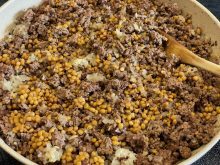The United Nations has declared 2016 the International Year of Pulses.
The aim is to increase awareness of the potential role pulse crops can have in the eradication of hunger, reduction of chronic health conditions, global food security and environmental sustainability.
There is much to learn about pulse crops and their potential as this year begins:
- Legumes are plants whose fruit is enclosed in a pod. Pulses are the dry edible seeds of legume crops.
- The UN’s Food and Agriculture Organization recognizes 11 types of pulses: dry beans, dry broad beans, dry peas, chickpeas, cow peas, pigeon peas, lentils, bambara beans, vetches, lupins and pulses nes (minor pulses that don’t fall into one of the other categories).
- Pulses have high levels of minerals and B vitamins, are high in protein, fibre and complex carbohydrates and yet are low in fat.
- Pulses contain 20 to 25 percent protein by weight, while wheat has 10 percent and meat has 30 to 40 percent.
- Pulses are important for people who have limited animal protein food sources or choose to eat vegetarian or vegan diets. They have higher amounts of the essential protein amino acid lysine, while cereals have higher amounts of the essential amino acids methionine and cysteine. Combining pulses with cereals or nuts results in a complete protein that contains all the essential amino acids the body needs in the appropriate amounts.
- Pulses contain soluble and insoluble fibres. Soluble fibre helps decrease blood cholesterol levels and control blood sugar levels, while insoluble fibre helps with digestion and regularity. The Canadian recommended daily intake of fibre is 38 grams per day of total fibre for men and 25 grams per day of total fibre for women. Eating 125 millilitres, or 1/2 cup, of pulses per day provides seven to 17 grams of fibre.
- Pulses are good for diabetics to eat because they contain complex carbohydrates. Some are digested slowly, which helps keeps the body’s blood sugar levels closer to normal. As a result, pulses are considered to have a low glycemic index.
- A 2014 analysis of existing research showed that eating pulses for at least three weeks significantly reduced LDLcholesterol levels. Eating 130 grams, or 3/4 cup, of pulses a day can lower cholesterol levels by about five percent. This reduction translates to a five to six percent reduction in heart attacks and stroke.
- The key minerals in pulses include iron, potassium, magnesium and zinc. The B vitamins folate, thiamin and niacin are also in abundance.
- Archaeological remains found in Anatolia (modern day Turkey) show that ancient agricultural production of chickpeas and lentils dates back to 7000-8000 BC. Wild relatives of lentils and peas are still seen in the southeast Anatolian region.
- Pulses improve the soil because they fix nitrogen into the soil, which reduces the need for chemical fertilizers.
- Pulse crops are highly water efficient, especially when compared to other protein foods. Split peas and lentils require only 50 litres of water per kilogram of seeds produced. Conversely, one kilogram of chicken requires 4,325 litres of water, one kilogram of mutton requires 5,520 litres and one kilogram of beef requires 13,000 litres of water during production. This low water requirement makes pulses a good choice in drier areas and drought prone regions.
- New varieties are more drought tolerant with higher yields.
- Pulse crops were first grown in Canada in the 1920s when immigrants from Syria grew lentils and chickpeas on farms in southwestern Saskatchewan. In the 1970s, University of Saskatchewan researchers encouraged farmers to include pulse crops in their seeding rotations for diversity and nitrogen fixing.
- Canada is the largest exporter of pulses in the world, exporting to more than 150 countries. Thirty percent of the world pea production and 40 percent of the world lentil production is Canadian. Beans, chickpeas and fababeans are also grown in Canada.
Read Also

A power of attorney document may no longer be enough
Recently, some financial institutions have begun imposing their own internal form of “verification” requirement with respect to powers of attorney.
A variety of initiatives have been launched to encourage Canadians to include more pulses in their diet.
For example, the pulsepledge.com website includes a searchable database of new and interesting pulse recipes, while pulses.org has created a database of international pulse recipes.
As well, chef Michael Smith of Prince Edward Island is developing pulse recipes for Canada’s International Year of Pulses promotions. Here’s one of his recipes.
Pulse tacos
Use your favourite beans, hot sauce and salsa.
Filling:
- 2 tbsp. canola oil 30 mL
- 2 onions, thinly sliced
- 6 cloves garlic thinly sliced
- 1 heaping tbsp. chili powder 18 mL
- 1 tsp. ground cumin 5 mL
- 1 c. green lentils 250 mL
- 19 oz. can beans or chickpeas, rinsed and drained 540 mL
- 2 c. water 500 mL
- 1/2 tsp. salt 2 mL
- 1/2 tsp. hot sauce 2 mL
Toppings:
- 1 head Bibb or iceberg lettuce
- 12 hard taco shells
- grated cheddar or taco blend cheese
Salsa:
- 1 bunch fresh cilantro
- 2 limes, cut into wedges
Splash canola oil into a large skillet or sauté pan over medium-high heat. Toss in onions, garlic, chili powder, and cumin. Sauté until vegetables soften and the spice flavours brighten. This should take three to four minutes. Stir in lentils, beans, water and salt. Bring to a slow, steady simmer. Cover tightly and continue slowly cooking until the lentils are tender, about 35 minutes. Stir in hot sauce.
Fit a full leaf of lettuce into a hard taco shell. This will hold the fillings in when the hard shell inevitably breaks. Fill each taco with a heaping spoonful of the lentil bean filling. Add cheese, salsa, and cilantro. Serve with lime wedges. Makes 12 tacos, Serves four to six. – Sources: pulsecanada.com, pulses.org, pulsepledge.com
Betty Ann Deobald is a home economist from Rosetown, Sask., and a member of Team Resources. Contact: team@producer.com.















